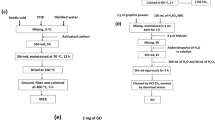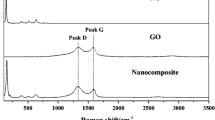Abstract
Titania-reduced graphene oxide nanocomposites have been prepared through facile hydrothermal method by a reaction between P25 as TiO2 source and graphene oxide. Reduction of graphene oxide and its reaction with P25 nanoparticles were achieved simultaneously at high temperature and pressure during the hydrothermal process with the minimum organic solvents. Chemical bonds, crystalline structure, morphology, porosity and light absorption of composites along with their photocatalytic activity under UV and visible light irradiation were investigated. Transmission electron microscopy images showed that P25 nanoparticles, with diameters about 25 nm, were dispersed on the sheets of reduced graphene oxide (RGO) homogeneously. A stronger interaction between P25 and RGO provided a red shift about 20 nm in the absorption edge of the composites. To set up a continuous tubular reactor made from thin layer of the prepared material, composite films were coated on the external surface of a steel tube to make an annular reactor. The reactor was equipped with UV or visible light sources to investigate the photocatalytic activity of the prepared composites in a continuous air flow contaminated with specified amount of acetaldehyde as a VVOC (very volatile organic compound) model molecule. Degradation efficiency of P25–RGO with 0.5 wt% RGO was significantly high under visible light irradiation, and about 70% conversion was observed using an air flow at normal conditions with specific flow rate of 17 ml min−1 and 500 ppm acetaldehyde, by 30 mg of the coated composite in the reactor. Composites with low amount of RGO would be an appropriate photosensitizer and electron acceptor to suppress the recombination of photogenerated electron–hole pairs to enhance the photocatalytic performance.







Similar content being viewed by others
References
Abdolhosseinzadeh S, Asgharzadeh H, Seop Kim H (2015) Fast and fully-scalable synthesis of reduced graphene oxide. Nature 5(10160):1–7. doi:10.1038/srep10160
Cong Y, Long M, Cui Z, Li X, Dong Z, Yuan G, Zhang J (2013) Anchoring a uniform TiO2 layer on graphene oxide sheets as an efficient visible light photocatalyst. Appl Surf Sci 282:400–407. doi:10.1016/j.apsusc.2013.05.143
Fan W, Lai Q, Zhang Q, Wang Y (2011) Nanocomposites of TiO 2 and reduced graphene oxide as efficient photocatalysts for hydrogen evolution. J Phys Chem C 115(21):10694–10701. doi:10.1021/jp2008804
Hay S, Obee T, Luo Z et al (2015) The viability of photocatalysis for air purification. Molecules 20(1):1319–1356. doi:10.3390/molecules20011319
Jin C, Cui X, Tian H, Wang X, Sun C, Zheng W (2014) Photo-less catalysis of TiO2-reduced graphene oxides. Chem Phys Lett 608:229–234. doi:10.1016/j.cplett.2014.06.007
Khalid NR, Ahmed E, Hong Z, Sana L, Ahmed M (2013a) Enhanced photocatalytic activity of graphene—TiO2 composite under visible light irradiation. Curr Appl Phys 13(4):659–663. doi:10.1016/j.cap.2012.11.003
Khalid NR, Ahmed E, Hong Z, Zhang Y, Ullah M, Ahmed M (2013b) Graphene modified Nd/TiO2 photocatalyst for methyl orange degradation under visible light irradiation. Ceram Int 39(4):3569–3575. doi:10.1016/j.ceramint.2012.10.183
Lan Y, Lu Y, Ren Z (2013) Mini review on photocatalysis of titanium dioxide nanoparticles and their solar applications. Nano Energy 2(5):1031–1045. doi:10.1016/j.nanoen.2013.04.002
Leary R, Westwood A (2011) Carbonaceous nanomaterials for the enhancement of TiO2 photocatalysis. Carbon 49(3):741–772. doi:10.1016/j.carbon.2010.10.010
Li Q, Li X, Wageh S, Al-Ghamdi AA, Yu J (2015) CdS/Graphene nanocomposite photocatalysts. Adv Energy Mater 5(14):1–28. doi:10.1002/aenm.201500010
Liu K, Zhang J-J, Cheng F-F, Zheng T-T, Wang C, Zhu J-J (2011) Green and facile synthesis of highly biocompatible graphene nanosheets and its application for cellular imaging and drug delivery. J Mater Chem 21(32):12034–12040. doi:10.1039/c1jm10749f
Liu S, Sun H, Liu S, Wang S (2013) Graphene facilitated visible light photodegradation of methylene blue over titanium dioxide photocatalysts. Chem Eng J 214:298–303. doi:10.1016/j.cej.2012.10.058
Low W, Boonamnuayvitaya V (2013) Enhancing the photocatalytic activity of TiO2 co-doping of graphene-Fe3+ ions for formaldehyde removal. J Environ Manage 127:142–149. doi:10.1016/j.jenvman.2013.04.029
Luo L-J, Zhang X-J, Ma F-J, Zhang A-L, Bian L-C, Pan X-J, Jiang F-Z (2014) Photocatalytic degradation of bisphenol A by TiO2-reduced graphene oxide nanocomposites. React Kinet Mech Catal 114(1):311–322. doi:10.1007/s11144-014-0761-8
Marcano D, Kosynkin D, Berlin J (2010) Improved synthesis of graphene oxide. ACS Nano 4(8):4806–4814. doi:10.1021/nn1006368
Min Y, Zhang K, Zhao W, Zheng F, Chen Y, Zhang Y (2012) Enhanced chemical interaction between TiO2 and graphene oxide for photocatalytic decolorization of methylene blue. Chem Eng J 193–194:203–210. doi:10.1016/j.cej.2012.04.047
Nguyen-Phan T-D, Pham VH, Yun H, Kim EJ, Hur SH, Chung JS, Shin EW (2011) Influence of heat treatment on thermally-reduced graphene oxide/TiO2 composites for photocatalytic applications. Korean J Chem Eng 28(12):2236–2241. doi:10.1007/s11814-011-0123-4
Novoselov K, Geim A, Morozov S (2004) Electric field effect in atomically thin carbon films. Science 306(5696):666–669. doi:10.1126/science.1102896
Pelaez M, Nolan NT, Pillai SC et al (2012) A review on the visible light active titanium dioxide photocatalysts for environmental applications. Appl Catal B 125:331–349. doi:10.1016/j.apcatb.2012.05.036
Perez-Padilla R, Schilmann A, Riojas-Rodriguez H (2010) Respiratory health effects of indoor air pollution. Int J Tuberc Lung Dis 14(9):1079–1086
Rokhsat E, Akhavan O (2016) Improving the photocatalytic activity of graphene oxide/ZnO nanorod films by UV irradiation. Appl Surf Sci 371:590–595. doi:10.1016/j.apsusc.2016.02.222
Shang Q, Tan X, Yu T, Zhang Z, Zou Y, Wang S (2015) Efficient gaseous toluene photoconversion on graphene-titanium dioxide nanocomposites with dominate exposed 001 facets. J Colloid Interface Sci 455:134–144. doi:10.1016/j.jcis.2015.05.036
Shao G, Lu Y, Wu F, Yang C, Zeng F, Wu Q (2012) Graphene oxide: the mechanisms of oxidation and exfoliation. J Mater Sci 47(10):4400–4409. doi:10.1007/s10853-012-6294-5
Shi M, Shen J, Ma H, Li Z, Lu X, Li N, Ye M (2012) Preparation of graphene-TiO2 composite by hydrothermal method from peroxotitanium acid and its photocatalytic properties. Colloids Surf A 405:30–37. doi:10.1016/j.colsurfa.2012.04.031
Sing KSW (1982) Reporting physisorption data for gas/solid systems with special reference to the determination of surface area and porosity (Provisional). Pure Appl Chem 54(11):2201–2218. doi:10.1351/pac198254112201
Stengl V, Bakardjieva S, Grygar TM, Bludská J, Kormunda M (2013) TiO2-graphene oxide nanocomposite as advanced photocatalytic materials. Chem Cent J 7(1):41–53. doi:10.1186/1752-153X-7-41
Szabó T, Berkesi O, Dékány I (2005) DRIFT study of deuterium-exchanged graphite oxide. Carbon 43(15):3186–3189. doi:10.1016/j.carbon.2005.07.013
Trapalis A, Todorova N, Giannakopoulou T, Boukos N, Speliotis T, Dimotikali D, Yu J (2016) TiO2/graphene composite photocatalysts for NOx removal: a comparison of surfactant-stabilized graphene and reduced graphene oxide. Appl Catal B 180:637–647. doi:10.1016/j.apcatb.2015.07.009
Wang F, Zhang K (2011) Reduced graphene oxide–TiO2 nanocomposite with high photocatalystic activity for the degradation of rhodamine B. J Mol Catal A Chem 345(1–2):101–107. doi:10.1016/j.molcata.2011.05.026
Wang J, Zhu H, Hurren C, Zhao J, Pakdel E, Li Z, Wang X (2015) Degradation of organic dyes by P25-reduced graphene oxide: influence of inorganic salts and surfactants. J Environ Chem Eng 3(3):1437–1443. doi:10.1016/j.jece.2015.05.008
Yu S, Yun HJ, Kim YH, Yi J (2014) Carbon-doped TiO2 nanoparticles wrapped with nanographene as a high performance photocatalyst for phenol degradation under visible light irradiation. Appl Catal B 144:893–899. doi:10.1016/j.apcatb.2013.08.030
Zhang X-Y (2010) Graphene/TiO2 nanocomposites: synthesis, characterization and application in hydrogen evolution from water photocatalytic splitting. J Mater Chem 20(14):2801–2806. doi:10.1039/b917240h
Zhang Y, Pan C (2011) TiO2/graphene composite from thermal reaction of graphene oxide and its photocatalytic activity in visible light. J Mater Sci 46(8):2622–2626. doi:10.1007/s10853-010-5116-x
Zhang H, Lv X, Li Y, Wang Y, Li J (2010a) P25-graphene composite as a high performance photocatalyst. ACS Nano 4(1):380–386. doi:10.1021/nn901221k
Zhang Y, Tang Z-R, Fu X, Xu Y-J (2010b) TiO2-graphene nanocomposites for gas-phase photocatalytic degradation of volatile aromatic pollutant: is TiO2-graphene truly different from other TiO2-carbon composite materials? ACS Nano 4(12):7303–7314. doi:10.1021/nn1024219
Zhang J, Xiong Z, Zhao X (2011) Graphene–metal–oxide composites for the degradation of dyes under visible light irradiation. J Mater Chem 21:3634–3640. doi:10.1039/C0JM03827J
Zhang N, Zhang Y, Xu Y-J (2012a) Recent progress on graphene-based photocatalysts: current status and future perspectives. Nanoscale 4(19):5792–5813. doi:10.1039/c2nr31480k
Zhang X, Sun Y, Cui X, Jiang Z (2012b) A green and facile synthesis of TiO2/graphene nanocomposites and their photocatalytic activity for hydrogen evolution. Int J Hydrogen Energy 37(1):811–815. doi:10.1016/j.ijhydene.2011.04.053
Author information
Authors and Affiliations
Corresponding author
Electronic supplementary material
Below is the link to the electronic supplementary material.
Rights and permissions
About this article
Cite this article
Ebrahimi, A., Fatemi, S. Titania-reduced graphene oxide nanocomposite as a promising visible light-active photocatalyst for continuous degradation of VVOC in air purification process. Clean Techn Environ Policy 19, 2089–2098 (2017). https://doi.org/10.1007/s10098-017-1393-2
Received:
Accepted:
Published:
Issue Date:
DOI: https://doi.org/10.1007/s10098-017-1393-2




